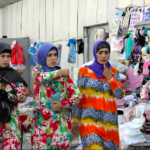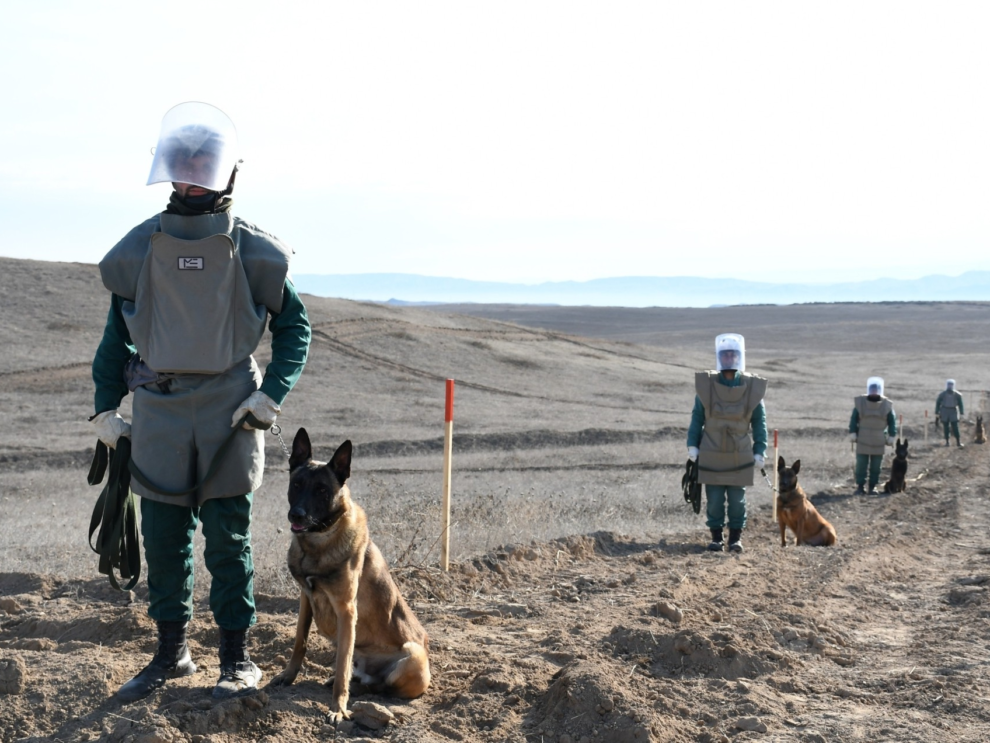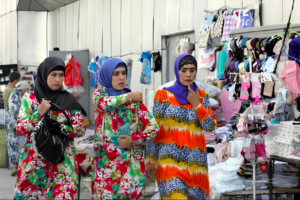Azerbaijan continues the arduous work of demining the territories it regained in the 2020 Second Karabakh War, accepting any international help offered. Questions remain, though, about the timeline and effectiveness of the work.
Tamam Jafarova was 21 years old when she stepped on a landmine in her native village of Gosha (Qoşa) in Azerbaijan’s northwestern Tovuz District in 1997 – about three years after the end of the First Karabakh War with Armenia.
She was employed as a teacher in the nearby village school at the time and spent her summers helping out with the family farm.
“The Armenians took all the cattle in my village. My family then bought one cow, and that was the only cattle we had,” she recalls. “I was going to the field to bring back our cow with my little sister and my little brother. And before I knew it, I stepped on a mine in the grazing field.”
Jafarova lost her left leg above the knee, and her right arm bears deep scars from the blast. The government provides her with a prosthesis, which gets replaced every two years. After the accident, she never married, and she still lives in the village with her brother.
But she isn’t limiting herself to farmwork. Over the years, she has participated in numerous conferences and trainings on the subject and taught mine awareness to fellow citizens in various mine-affected areas.
Jafarova is one of hundreds of Azerbaijanis hurt or killed by landmines over the past three decades. Her case is exceptional, though, in that it occurred near the Armenia-Azerbaijan border, in an area mined in brief incursions during the first war (1991-94).
The vast majority of mines in Azerbaijan were laid in the areas around Nagorno-Karabakh that were under Armenian occupation between the first and second wars.
Accordingly, the number of Azerbaijanis hurt in mine blasts has skyrocketed in the past three years, since Azerbaijan won the Second Karabakh War and re-established control over most of the territory it lost in the first one.
Since the war there have been 180 mine explosions, mainly in the newly retaken lands, that have wounded or killed 303 people, according to the state demining agency, ANAMA. The victims include soldiers, deminers, and civilians.
Only a tiny fraction of the more than 600,000 people displaced by the first war in these territories have been able to go home. The pace of resettlement has been glacial, largely due to the presence of as many as one million landmines. So far only around 2,000 people have been resettled.
(The civilians who end up stepping on mines are mainly construction or utility workers or those who illegally pass onto the territories. Other than those already resettled, the only way to visit Karabakh is either bus tours or government-sponsored events.)
According to Hafiz Safikhanov, chair of the Azerbaijan Campaign to Ban Landmines, since the end of the war on November 10, 2020, until June this year 82,848 hectares of land in Karabakh were cleared of mines, which he said amounts to just above 7 percent of the total retaken lands.
“Oftentimes, in the context of rebuilding Karabakh, we say that we started from zero – referring to all the works carried out in liberated areas after 30 years of Armenian occupation. But the truth is that we started below zero, meaning there is work you have to do underground before you start building houses,” Safikhanov said, in an interview with Eurasianet.
In 2022, Azerbaijani President Ilham Aliyev projected that clearing all the landmines in the region would require 30 years and $25 billion.
Safikhanov says that that timeline could be accelerated if significantly more resources were directed towards solving the problem.
“Each year nearly 100 million manats [about $59 million] are allocated from the state budget for mine clearance alone. That includes training of more demining personnel and the purchase of modern technologies – remote-controlled mine-searching robots – and dogs. In June, even mine-searching rats were purchased and brought to the country,” he said.
On top of that, Azerbaijan receives aid for mine clearance from countries like the UK, the U.S., Canada, Israel and Hungary. In August, the UK ambassador to Azerbaijan announced that his country would provide 500,000 pounds (about $630,000) to support mine action in Azerbaijan, totaling 1,500,000 pounds for the same cause since 2020. In July, the U.S. embassy in Baku disclosed that the country has allocated $2.5 million to Azerbaijan’s cause since November 2021. In April, the European Council’s representative in Azerbaijan Peter Michalko tweeted that the EU member states had provided 8 million euros in total for mine clearance.
Safikhanov said that, generous as these sums are, they are not enough. It’s like “trying to empty the ocean with a bucket,” he said. “There is a statistic that planting one mine can cost as cheap as $3, but removing and neutralizing can cost up to $1,000.”
Deminers generally draw on two sources of information in locating mines, he explained. One is the people living near mined areas who have stories of family members or livestock stepping on mines. But this is only useful along the periphery of the retaken territory.
The other is Armenian maps giving the coordinates of mined areas. This issue has been one of many fields of political battle between the two countries in the post-2020 war era.
After the first few post-war mine casualties, Azerbaijan began using Armenian prisoners of war as leverage to get hold of these maps. In June 2021, a deal was struck – Azerbaijan released 15 POWs in return for maps of 97,000 anti-tank and anti-personnel mines in the retaken city of Aghdam.
There have been two further deals on the transfer of mine maps, purportedly covering a total of 400,000 mines. But President Aliyev complained this July that Armenia still refuses to provide maps for 600,000 mines and that the maps it has provided are only “25 percent accurate.”
“Not providing mine maps is a continuation of Armenian terror against us,” he said.
(In October Armenia’s prime minister said Yerevan had given all its mine maps to Baku and does not have any “better or more accurate” ones.)
A few months before blockading the remaining Armenian-controlled part of Nagorno Karabakh but closing the only road connecting the region with Armenia, Baku alleged that the road was still being used to transfer mines to the region.
The Mine Action Agency of Azerbaijan, ANAMA, currently employs over 1,800 personnel (compared to around 500 before the Second Karabakh War). It uses 58 remote-controlled robots and 113 dogs; it has recently started using African giant-pouched rats as well.
Some deminers are trained by British specialists with the Mines Advisory Group.
HALO Trust, another UK-based mine-clearing organization, has been working inside Armenian-administered Nagorno-Karbakh since the first war. Azerbaijan has long objected to its presence there because the charity never sought its permission.
Safikhanov said countries should band together to fight the common scourge of landmines.
“It would be in their best interests if Armenia, Georgia and Azerbaijan grouped up and brought their efforts together to clear mines in the region. We should not leave this disease to the next generation. Mines don’t discriminate.”
Source : EURASIA











